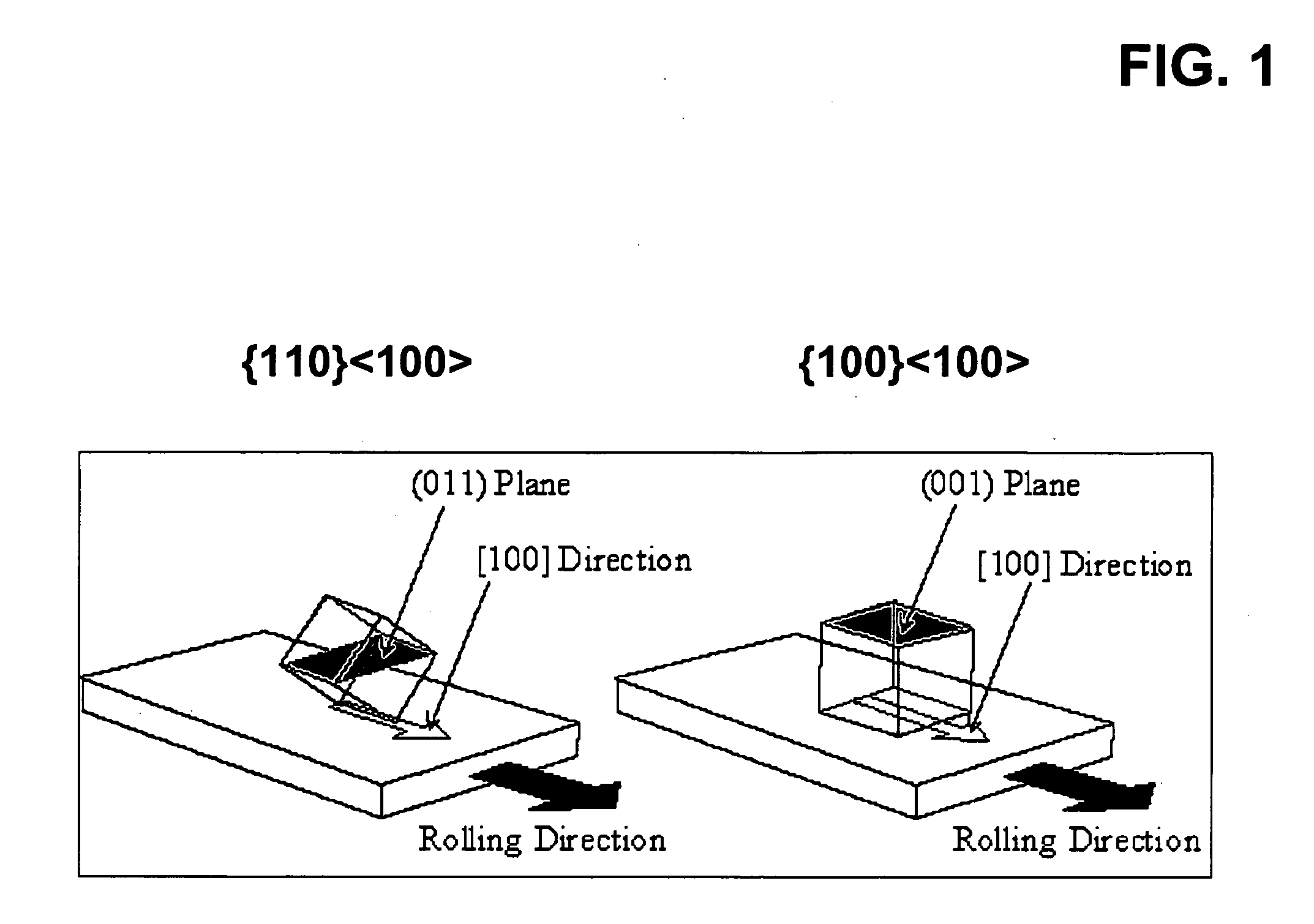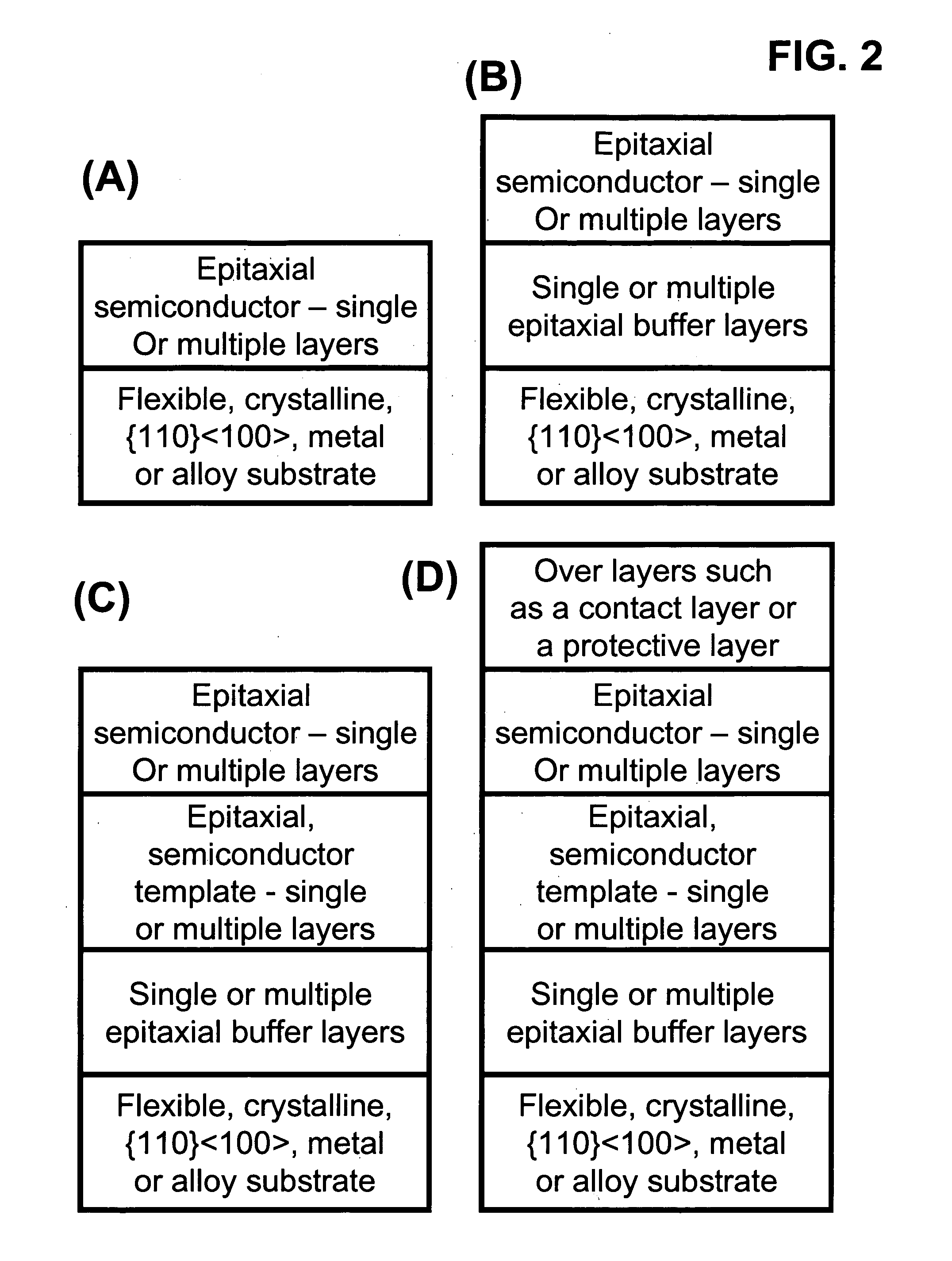Semiconductor-based, large-area, flexible, electronic devices on <100> oriented substrates
a technology of semiconductors and substrates, applied in the field of semiconductor-based, large-area, flexible, electronic devices on <100> oriented substrates, can solve the problems of unrealized solar energy promise, prohibitively expensive cost of single crystal substrates, unfavorable price/performance metric, etc., and achieve high performance
- Summary
- Abstract
- Description
- Claims
- Application Information
AI Technical Summary
Benefits of technology
Problems solved by technology
Method used
Image
Examples
example 1
[0108]Starting with a secondary recrystallized, Fe-3 at % Si substrate, with a {110} orientation, a 10-75 nm thick, epitaxial layer of TiN is grown by electron beam evaporation, sputtering, pulsed laser ablation or chemical vapor deposition at a substrate temperature in the range of 300-850° C. This is followed by deposition of an epitaxial Si layer using chemical vapor deposition in the temperature range of 300-900° C.
example 2
[0109]Starting with a secondary recrystallized, Fe-3 at % Si substrate, with a {110} orientation, a 10-75 nm thick, epitaxial layer of TiN is grown by electron beam evaporation, sputtering, pulsed laser ablation or chemical vapor deposition at a substrate temperature in the range of 300-850° C. This is followed by deposition of a 10-75 nm thick, epitaxial, layer of MgO by electron beam evaporation, sputtering, pulsed laser ablation or chemical vapor deposition at a substrate temperature in the range of 300-850° C. This is followed by deposition of an epitaxial Si layer using chemical vapor deposition in the temperature range of 300-900° C.
example 3
[0110]Starting with a secondary recrystallized, Fe-3 at % Si substrate, with a {110} orientation, a 10-75 nm thick, epitaxial layer of γ-Al2O3 is grown by electron beam evaporation, sputtering, pulsed laser ablation or chemical vapor deposition at a substrate temperature in the range of 300-850° C. This is followed by deposition of an epitaxial Si layer using chemical vapor deposition in the temperature range of 300-900° C. Numerous reports exist in the literature of epitaxial growth of Si on γ-Al2O3 (see for example, Liwen tan, Qiyuan Wang, Jun Wang, Yuanhuan Yu, Zhongli Liu and Lanying Lin, “Fabrication of novel double-hetero-epitaxial SOI structure Si / γ-Al2O3 / Si,” Journal of Crystal Growth, vol. 247, pp. 255-260, 2003; K. Sawada, M. Ishida, T. Nakamura and N. Ohtake, “Metalorganic molecular beam epitaxy of films on Si at low growth temperatures,” Appl. Phys. Lett., vol. 52, pp. 1672-1674, 1988; M. Shahjahan, Y. Koji, K. Sawada and M. Ishida, “Fabrication of resonance tunnel diode...
PUM
 Login to View More
Login to View More Abstract
Description
Claims
Application Information
 Login to View More
Login to View More - R&D
- Intellectual Property
- Life Sciences
- Materials
- Tech Scout
- Unparalleled Data Quality
- Higher Quality Content
- 60% Fewer Hallucinations
Browse by: Latest US Patents, China's latest patents, Technical Efficacy Thesaurus, Application Domain, Technology Topic, Popular Technical Reports.
© 2025 PatSnap. All rights reserved.Legal|Privacy policy|Modern Slavery Act Transparency Statement|Sitemap|About US| Contact US: help@patsnap.com



